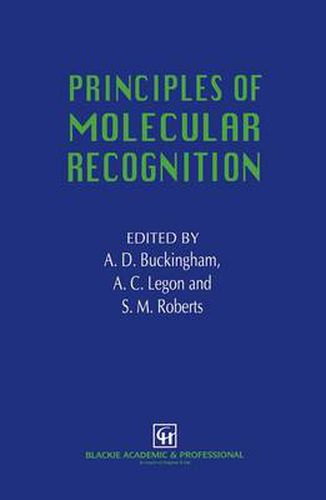Readings Newsletter
Become a Readings Member to make your shopping experience even easier.
Sign in or sign up for free!
You’re not far away from qualifying for FREE standard shipping within Australia
You’ve qualified for FREE standard shipping within Australia
The cart is loading…






This title is printed to order. This book may have been self-published. If so, we cannot guarantee the quality of the content. In the main most books will have gone through the editing process however some may not. We therefore suggest that you be aware of this before ordering this book. If in doubt check either the author or publisher’s details as we are unable to accept any returns unless they are faulty. Please contact us if you have any questions.
The importance of molecular recognition in chemistry and biology is reflected in a recent upsurge in relevant research, promoted in particular by high-profile initiatives in this area in Europe, the USA and Japan. Although molecular recognition is necessarily microscopic in origin, its consequences are de facto macroscopic. Accordingly, a text that starts with intermolecular interactions between simple molecules and builds to a discussion of molecular recognition involving larger scale systems is timely. This book was planned with such a development in mind. The book begins with an elementary but rigorous account of the various types of forces between molecules. Chapter 2 is concerned with the hydrogen bond between pairs of simple molecules in the gas phase, with particular reference to the preferred relative orientation of the pair and the ease with which this can be distorted. This microscopic view continues in chapter 3 wherein the nature of interactions between solute molecules and solvents or between two or more solutes is examined from the experimental standpoint, with various types of spectroscopy providing the probe of the nature of the interactions. Molecular recognition is central to the catalysis of chemical reactions, especially when bonds are to be broken and formed under the severe con straint that a specific configuration is to result, as in the production of enan tiotopically pure compounds. This important topic is considered in chapter 4.
$9.00 standard shipping within Australia
FREE standard shipping within Australia for orders over $100.00
Express & International shipping calculated at checkout
Stock availability can be subject to change without notice. We recommend calling the shop or contacting our online team to check availability of low stock items. Please see our Shopping Online page for more details.
This title is printed to order. This book may have been self-published. If so, we cannot guarantee the quality of the content. In the main most books will have gone through the editing process however some may not. We therefore suggest that you be aware of this before ordering this book. If in doubt check either the author or publisher’s details as we are unable to accept any returns unless they are faulty. Please contact us if you have any questions.
The importance of molecular recognition in chemistry and biology is reflected in a recent upsurge in relevant research, promoted in particular by high-profile initiatives in this area in Europe, the USA and Japan. Although molecular recognition is necessarily microscopic in origin, its consequences are de facto macroscopic. Accordingly, a text that starts with intermolecular interactions between simple molecules and builds to a discussion of molecular recognition involving larger scale systems is timely. This book was planned with such a development in mind. The book begins with an elementary but rigorous account of the various types of forces between molecules. Chapter 2 is concerned with the hydrogen bond between pairs of simple molecules in the gas phase, with particular reference to the preferred relative orientation of the pair and the ease with which this can be distorted. This microscopic view continues in chapter 3 wherein the nature of interactions between solute molecules and solvents or between two or more solutes is examined from the experimental standpoint, with various types of spectroscopy providing the probe of the nature of the interactions. Molecular recognition is central to the catalysis of chemical reactions, especially when bonds are to be broken and formed under the severe con straint that a specific configuration is to result, as in the production of enan tiotopically pure compounds. This important topic is considered in chapter 4.